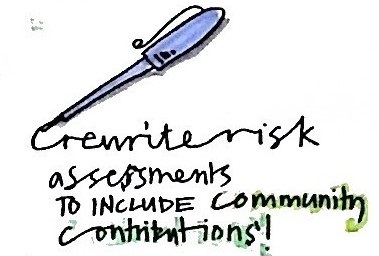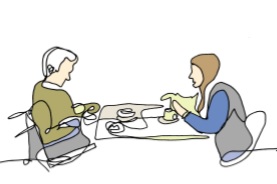Find below a range of resources on the following topics:
- The impact of physical environment and belongings
- Are care homes like a family?
- Eating together
- Building community connections
- Going out and transport
- Risk assessment
- Locked environments (forensic hospitals)
- Closing a care home and transferring to a new place
The last homely house
What makes a house a home? When a person with disabilities moves from their own home to live in a residential care facility or some other place, they lose their home. Others retain their own home, but it is invaded by an army of well-meaning health and care staff, who unwittingly make the person homeless, even if they still hold the deeds or the tenancy. If we understand what makes a house a home, then we can perhaps learn to uphold the person’s sense of home. For an introduction, read a short blog about beds and another about stairs, or go for a detailed reviewed of the literature at How to make a homely care home.
We’re just like a family
As well as calling on ideas of home, many residential care facilities choose to describe themselves as ‘just like a family’. In this companion piece to How to make a homely care home we consider How to make a family-based care home.
How to close or relocate a service
Medieval texts on the art of dying focused on the final moments of good people and the modern hospice movement has added quality of life to the palliative care agenda. Lessons can be borrowed from the literal death of the individual and applied to the closure of organisations, teams and services that are killed off by Covid-19, austerity or the machinations of commissioning. Should we think together about closure and relocation of health and social care services?
Painting the minibus
Should vehicles that belong to health and social care services carry their name, logo or other messages? Do these coachpainted adverts deserve the name stigmobile? Read more…

Inclusive risk assessment
Do risk assessment forms commonly include the expectation that people will participate in inclusive community settings and engage with the general public? A long risk assessment form for outings from a care home or similar setting is offered here here along with a one-page summary called ‘7 Great Questions.
Time to Connect
In this project funded by the Big Lottery, I worked with NDTi colleagues to support staff working in care homes and people involved in TimeBanks. The goal was to support care home residents to get a more included life in the community. Here’s some of the resources generated through the project:
- The final Evaluation Report
- A new comic strip explaining the Inclusion Traffic Lights
- A declaration for care homes setting out the Right to Go Out – here.
- Risk assessment tools for outings – the long resource document and 7 Great Questions.
- Resources on informal lift-sharing. These include a long resource document, a poster, an A4 leaflet, a DBS flowchart and questions to ask the driver and passenger. If your service has a vehicle, you might also like to see the webpage called Painting the Minibus.
- Resources on the importance of staff and residents Eating together. A long resource paper is available, as well as a poster and a leaflet.
- A review of Care Home provider websites to find out how they describe the opportunities that residents have to engage in the life of the community beyond the home.
- Nine ways to connect your care home with the community shows what homes have done to both invite local people in to visit residents and to support poeple to go out and contribute to community life beyond the perimeter fence. A longer version showing where the data came from is available here.

Eating together
As highlighted above, we have been asking if staff in congregate care settings sit down to a shared meal with the people that they support. Who pays? When people go out and call at a cafe, pub or restaurant, do the staff eat and who pays for the meal? Read more…
Striving for Excellence in locked rehabilitation
This programme is largely for independent and voluntary sector providers of locked residential rehabilitation services for people with mental health issues or learning disabilities living in the English East Midlands. It comprises (i) a series of seminars for key staff and people using services to promote a more personalised and inclusive approach; (ii) a shared sense of what excellent services look like, captured in an excellence framework; (iii) learning exchange visits between members which lead to individual action plans for each service; and (iv) stories of how services are striving for excellence that capture and share ideas for service improvement. We have recently developed a page of resources here on the introduction of the smoking ban. Networking groups in the East Midlands include:

Recent Comments